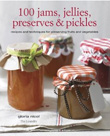BLOOD ORANGE AND PINK RHUBARB
Sunday February 02nd 2014, 2:52 pm
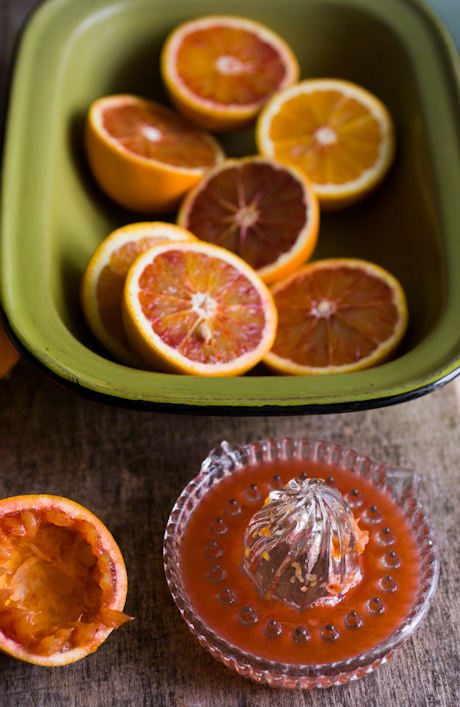
I haven’t posted on my blog for ages, so long in fact that I’ve forgotten how. This morning I found myself eating marmalade straight from the jar with a spoon and savouring the flavours; a fresh citrus hit with a tangy aftertaste. I could smell the light scent of cardamon from the jar, but should it perhaps be stronger in the syrup? Savouring and ruminating. The overall result was a good one creating an instinctive response to down another spoonful. So it seemed a fitting time to share the recipe. I have deemed this preserve a success and love the idea that others will enjoy it too.
Last week my quest for new season citrus gave the perfect excuse, in case one were needed, to treck off to Monmouth to see what Munday & Jones, my favourite local greengrocers, had to offer. They did not disappoint with a crate of blood oranges and some super perky looking early Yorkshire rhubarb on sale, the colours of which were enough to instantly lift my heart, but then I am after all a fruit geek.

I decided to make a marmalade that is a variation on a previous recipe from 2011, pink grapefruit, rhubarb and cardamon marmalade, simply substituting blood oranges for the ruby grapefruit. Yorkshire rhubarb doesn’t come cheap, so this is a good recipe to make a small amount go a longer way. It also meant I had a few sticks left over to make an upside down polenta cake as well.
As I mentioned, I am still undecided whether the cardamon could do to have a bit more impact. I freshly ground the spice in a pestle and mortar, placing it pods and all in a muslin bag to macerate with the rhubarb. Perhaps the cardamon I have could be fresher, who knows? I might buy some new for next time I make this marmalade. But still, too much cardamon would not be good either. It is always a very exacting thing when using spices and herbs in preserves, but better to underdo than over. Of course the ideal is to get it bang on!
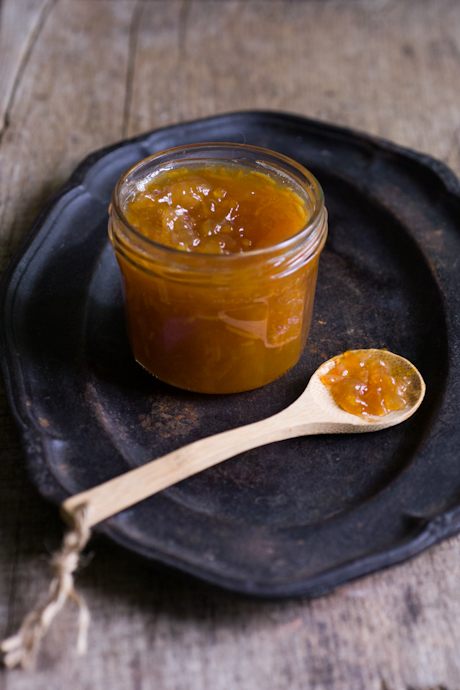
BLOOD ORANGE, RHUBARB AND CARDAMON MARMALADE
Makes approx 1.3kg (3lbs)
0.4Kg (1lb) rhubarb
1kg (2.2lbs) sugar
juice of 1 lemon
seeds from 14 cardamom pods, crushed
800g (1.75 lb ) blood oranges
Rinse the rhubarb stems and chop into 1cm (1/2 in) evenly sized pieces, slicing thicker stems lengthwise to make the pieces uniform. Place them in a bowl with the sugar and lemon juice. Tie the crushed cardamom seeds, pods and all, in a piece of muslin and push them inbetween the rhubarb, then cover with baking paper or clingfilm and leave overnight or for up to 24 hours, so the juices ooze out of the rhubarb and turn the sugar to syrup.
Wash the blood oranges and remove the peel with a sharp knife or potato peeler, leaving as much of the pith on the fruit as possible. Finely cut the peel into shreds. Squeeze the fruits, collecting the juice and tie the remaining pulp, pith and pips together in a muslin bundle. Place the shreds, juice and bundle in a pan, add 1.4ltr (2 1/2pt) water and simmer for 2 – 2 1/2 hours until the peel is cooked through and tender. Remove the muslin bundle and, when cool enough to handle, squeeze the juice from it back into the pan, then discard. Pour the peel through a sieve and collect and measure the liquid, adding more water if necessary to make it up to 1ltr (1 3/4 pts).
Prepare the jars and canner if you plan to hot water process the marmalade, otherwise, make sure your jars and lids are clean and place them in a warm oven to heat and sterilise. Place the cooked shreds, cooking liquid and the contents of the rhubarb bowl in a preserving pan and bring slowly to the boil, stirring to make sure all the sugar is dissolved. Bring to a rolling boil and cook on a high heat until setting point is reached, that is when a small blob of the syrup on a cold plate quickly forms a skin when you run your finger across the surface. It took me 20-25 minutes for the marmalade to reach setting point at a fast rolling boil, showing 104C (220F) on a thermometer. Remove the cardamom bundle.
Fill the jars, leaving the appropriate amount of headroom for canning, and seal. Hot water process for 10 minutes, then remove from the canner, leave till cold and test that the lids are sealed. Label and store. Alternatively, without canning, top jars with sterilised lids or use traditional wax paper circles and cellophane with elastic bands to seal. This marmalade should store safely without canning, but hot water processing will make doubly sure that your jam will keep and store without a hitch.
A MARMALADE MAKERS BLUEPRINT
Tuesday March 13th 2012, 11:04 pm

The big citrus preserving fest is just about over now. The Seville oranges have finished for the year and though there is always some citrus fruit available to buy all year round, with a plentiful supply of rhubarb just around the corner, I’ve had quite enough of the colour orange and am ready to don my rose tinted spectacles. Actually I haven’t made too much marmalade this year for one reason or another, but full of the usual good intentions still managed to buy the fruit anyway.
So time to clear the decks. That bowl of kumquats that I searched so earnestly to find, that pomelo that has sat patiently in the kitchen for the last few weeks and the handful of ruby oranges that I had almost forgotten were there, all need using up pronto. And then there are unwaxed lemons, 2 limes with peel starting to yellow and 3 bog-standard oranges that somehow got mixed in with the blood oranges at the fruit and veg shop. Oh, and a few bitter Seville oranges too. So to celebrate the last of the citrus why not use the whole lot in one fell swoop.
In some ways a recipe for this fruit-medley marmalade isn’t necessarily that useful to anyone else as the chances of you having the same mixture of fruits may be unlikely and the idea of going out with a shopping list for this exact combination fruitless. But knowing some basic principles for making marmalade is useful and can encourage everyone to use what they have as well as give you confidence to do your own thing if you fear stepping outside of the box. If that all sounds too much like hard work, by all means follow the recipe to the letter or sample a marmalade made earlier; pink grapefruit, rhubarb and cardamon marmalade or gooseberry and lime marmalade or perhaps lemon, fig and lavender marmalade, which is a good one for making just about any time during the year.
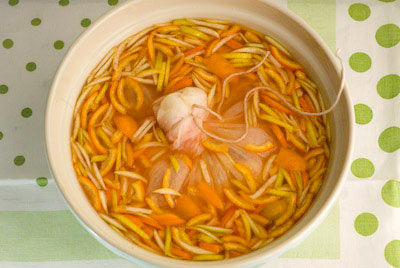
I love marmalade with a tart edge to it rather than being too sweet, so using bitter oranges suits me down to the ground. There is a difference between a bitter marmalade and a BITTER marmalade, the latter caused by the inclusion of the fruit’s pith. An overpowering unpleasant bitterness somehow coats the inside of your mouth and stays with you for ages after you’ve eaten your toast! I also love peel in my marmalade, lots of peel. Without it marmalade would simply be jelly! Hand cutting peel can be a tedious part of the process and it is hard to get a really fine even cut. For me this is all part of the ceremony of marmalade making, though luckily I don’t make huge batches. I do have a special bean shredding attachment for my Kenwood Chef which can do the job neatly, easily and quickly, though rarely use it, but if you intend to make marmalade big time it might be worth finding something similar to streamline the job.
The peel needs to be really well cooked first, seemingly overcooked, as it candies and hardens once it is boiled in the sugar syrup. Jane Hasell-McCosh, who founded and organises the annual Marmalade festival at her home, Dalemain Mansion, Nr Penrith, told me that undercooked peel is the most common reason for entries being marked down. The peel should first be cooked until when pressed between finger and thumb it disintegrates, and that can take between 1-2 hours of slow cooking to achieve. Of course, if you like a chewier texture, cook it for less time but don’t expect any rosettes for your efforts.
Different kinds of citrus fruits contain varying amounts of pectin, the stuff that helps jam to set, so you do need to do whatever you can to make the most of what pectin there is. Tying pips and pith into a bundle with muslin and soaking them with the peel in the water or juice overnight helps to extract the available pectin. I have never found it necessary to add extra pectin to my marmalade.
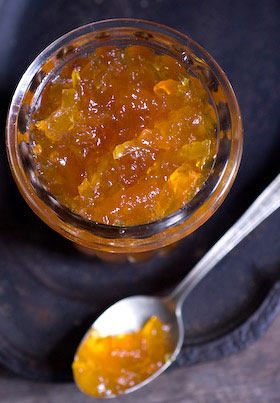
Use your own combination of citrus fruits. You could include grapefruits, mandarins and sweet oranges as alternatives. Roughly match the total weights shown in the recipe but don’t get too hung up on matching measurements exactly.
MIXED CITRUS MARMALADE
Makes approx 1.25Kg (4 x 1/2 pint jars and a bit)
Fruit with combined weight approx 1240g (2 3/4lbs):
kumquats (325g / 12oz)
1 pomelo (465g / 1lb)
3 Seville oranges (325g / 12oz)
1 lemon (125g / 4 oz)
300ml (1/2 pt) mixed citrus fruit juice (I used blood oranges and limes, close to past their prime but still full of juice)
1.2ltrs (2 1/4 pts) water
approx. 800g (1 3/4lbs) sugar
Wash and scrub all the fruit and drain in a colander. Cut the kumquats lengthways into quarters and remove and collect the pips. Remove the peel from the pomelo, Seville oranges and lemon. Pull away the thick pith from the pomelo and any from the oranges and lemon that comes away easily and discard it, then roughly chop the flesh from the fruits, collecting it together with any juice and the kumquat pips. Finely chop the peel into shreds. This made approximately 360g (12oz) chopped peel and 750g (1 1/2lbs) pips and flesh. Wrap the pips and flesh into a bundle with muslin tied securely with string.
Place the peel, muslin bundle, juice and water in a bowl and leave to soak for 12-24 hours. Put everything from the bowl into a pan with a lid, bring to a simmer and cook gently until the peel is soft, which may take 1 – 2 hours. Remove the muslin bag, collecting any liquid that drips from it. Separate the peel from the juice by pouring through a sieve over a bowl, then measure and weigh them both separately.
At this stage it made 700ml (1 1/4pts) juice and 480g (1lb) cooked peel. To calculate how much sugar I needed I made two calculations; one for the amount of juice and one for the weight of the peel then added them together. I choose a classic sugar to juice ratio as used for making a jelly of 400g (14oz) sugar to every 600ml (1 pint) juice = 460g (1lb), plus 70% sugar to weight of peel = 336g (12oz). 460g (1lb) + 336g (12oz) = 796g Rounded up to 800g (1 3/4lbs).
Prepare clean jars and lids by sterilising them in a low oven, keeping them warm till needed. If you plan to can (water process) your marmalade, prepare the water bath and jars and place jar seals in a pan of hot water on the hob.
Place the peel, juice and sugar in a preserving pan and stir over a gentle heat until the sugar is dissolved, then turn up the heat and bring to a rolling boil until the marmalade reaches setting point (a blob of the syrup on a plate quickly forms a skin that wrinkles when you push a finger over it). This took me about 10 minutes to achieve. Skim if necessary and allow the marmalade to cool for 5-10 minutes then stir to distribute the peel. Pour the marmalade into hot jars and seal. If you are canning your jam, process for 5 minutes then remove from the canner. Leave till cold, then test the seals. Don’t forget to label and date your marmalade.
LOST IN TRANSLATION
Friday January 22nd 2010, 6:15 pm
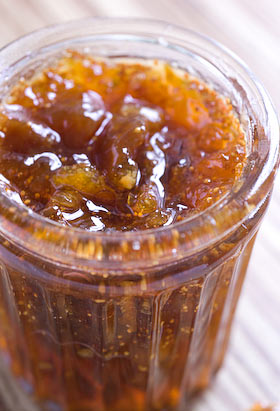
When I was a kid, my friends aunt, who was some sort of food scientist, told me that if you looked at an apple with a bad patch on it, under a microscope, you would see that the badness goes far beyond the brown bit, like spreading mycelium or the roots of a plant. This information was told as a warning, to not think it enough to just cut away the bad part and eat the rest, as what lurks beneath unseen might kill you! As I say, I am recalling a childhood memory here to dramatic effect.
Needless to say, I have always remembered this advice yet always chosen to ignore it. I was brought up to be made of sterner stuff. I follow a scale of food offness of my own design and ‘it hasn’t done me any harm’. I know that there are others whose standards in this regard are much higher than mine and just in case you are by now doubting my credentials and casting aspersions on my forthcoming artisan preserve venture, I do have an official food hygiene certificate.
For 2010, I, along with around 130 others, am taking part in Tigress’ Can Jam Challenge, an idea devised by fellow US based blogger tigressinajam, (see also tigressinapickle). The idea, to choose a different seasonal ingredient each month that can be canned. You can read the challenge outline here. It is all about ‘canning’. In the UK we don’t ‘can’ anyway, we ‘bottle’ and even that is a niche activity. Bottling, in case you don’t know, is a way of preserving food in special glass jars by employing either a hot water bath on the cooker hob or an oven method so the foodstuff is rendered sterile and will thus store in your larder for ever more. Bottling was once popular in the UK, especially during the wartime ‘make do and mend’ era. It went right out of fashion with the advent of the freezer but now seems to be making a come back with the move back to home grown fruit and veg and other eco considerations. As I am keen to know all about it, even though I am generally of the ‘scrape any mould off the top then eat the jam beneath’ school of thought, I intend to embrace the challenge and run with it.
As regular readers will already know, I am a passionate jam, chutney and pickle maker, all activities which in the US seem to come under the canning umbrella but that here somehow don’t. Basically putting your preserves through this canning process will make doubly certain that they will keep and not become contaminated. Canning requires the use of special Kilner jars (or Mason Ball jars in the US) which need new seals every time you use them. These traditional style jars, invented in 1842, have recently been reintroduced and I sell them in my shop. Unlike in the US, you can’t buy complete canning kits here with all the bits and bobs you need to get started, but you can buy some of the equipment, the rest you have to improvise. Anyhow, as the year unfolds I will be able to write about what I discover.
In order to meet the criteria of the challenge, it does mean that any preserves I make must be processed in a hot water bath, or at least I must say they are! Have you lot in the States not heard of the cellophane circle and elastic band method of sealing your jam?
January has a citrus theme. It must be wonderful to pick your ingredient straight from the tree, as some of the other challenge participants are able to do. I had to buy my fruit as none is grown here. Here is my first recipe for the 2010 Tigress’ Can Jam Challenge.
LEMON, FIG & LAVENDER MARMALADE
I am a massive fan of traditional bitter seville orange marmalade and this marmalade is just as tangy and fabulous. The lavender note adds an unusual flavour but isn’t at all over powering or over flowery. A few words first on ingredients; choose lemons that are organic where possible and unwaxed always, for this preserve. I had trouble finding dried figs without a load of gloop surrounding them, as they seem to be sold like this in supermarkets for ready-eating. Eventually I found some really nice dried Lerida figs in the health food shop. Dried lavender can vary a lot. I sell Snowshill lavender, grown in Worcestershire, sold by the scoopful in my shop and it is highly scented and natural. If you can’t find one with a good fresh scent, then please just leave it out; if you use it, it wont bring anything useful to the party.
Makes 1.3kg (3lb)
5 unwaxed lemons, approx 600g (1lb 5oz) plus 1 other lemon
400g (14oz) dried figs
25g (1oz) dried lavender
1kg (2lbs 4oz) sugar
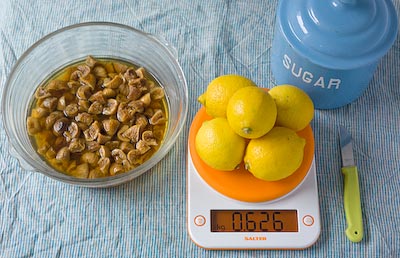
Heat the oven to 180C/ 350F/ Mk 4. Wash the 5 lemons and place in a lidded heat-proof casserole with 650ml (1 1/8pts) water, so the fruits just begin to float. Bring to a simmer, put the lid on and place in the oven to slow cook for 2 1/2 to 3 hours.
Remove the stalks from the figs and chop them into 1cm (3/8in) sized pieces (or smaller or bigger as you like, remembering they swell up as they reconstitute). Place in a preserving pan with 650ml (1 1/8pts) of water and leave them to soak while the lemons are poaching.
Remove the casserole from the oven and lift the lemons carefully with a slotted spoon out of the liquid into a sieve placed over a bowl to catch any drips. Leave them till cool enough to handle then cut each lemon in half and scoop out all the innards, collecting all the pulp and pips in a piece of muslin. Tie the muslin into a bundle and add to the preserving pan along with the poaching liquid and any liquid collected in the bowl. Chop the lemon skins finely into strips and keep on one side. Tie the dried lavender in another piece of muslin to make a bundle and add that also to the pan. Bring to the boil and simmer for 20 minutes.

Take off the heat. Remove the pulp and pip bundle and add the chopped lemon peel as well as the juice from the remaining lemon, passing it through a sieve to remove any pips if necessary. Add the warmed sugar and stir until completely dissolved then heat, bringing the pans contents to a rolling boil and test for a set after about 10 minutes and every 3-5minutes after that until setting point is reached. If you haven’t ever done this before this means that a blob of the syrup on a cold plate will readily form a skin that wrinkles when you push your finger across it. Take the pan off the heat whilst testing.
Turn off the heat, remove the lavender bundle and leave the jam to rest for 15 minutes then stir to distribute the pieces evenly before pouring into hot, clean, sterilised jars. Seal with either waxed paper discs and jam pot lids or the bottle seals and screw tops if intending to hot water process, in which case place the jars in the water bath and process for 10 minutes. For more info about how to hot water process your preserves, refer to the guide here. Leave your jars until cold and don’t forget to label and date them.
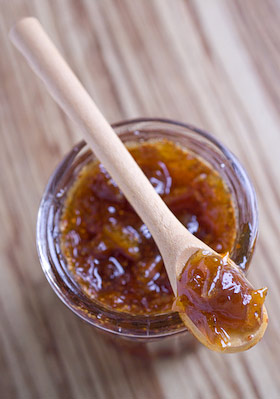
HOW TO MAKE MARMALADE
Tuesday February 12th 2008, 9:43 am

It wasn’t that straightforward finding Seville oranges this year and as the season is only for a few weeks straddling January and February I had to seek them out. I managed to order some in specially from the organic deli, which fortunately is very close by. When I went to the one and only greengrocers in the nearest town it had sadly closed down a week before. So Tesco has managed to put another independent out of business and another business that thought it was enough to just sell produce without the help of recipe cards and a loyalty points scheme has learnt the hard way.
Thankfully I now have some beautiful Seville oranges to cheer me up. Last year I made two lots of marmalade using different techniques to prepare the orange peel. For the first batch I pared and chopped all the peel at the beginning which takes ages but is a ritual with some therapeutic value, at least for the first half an hour or so until the novelty wears off. For the second batch I poached the oranges in my wonderful cast iron pot in the Rayburn for three hours then scooped out the innards and chopped the peel. I think the second method is the easiest and now definitely the one I prefer.
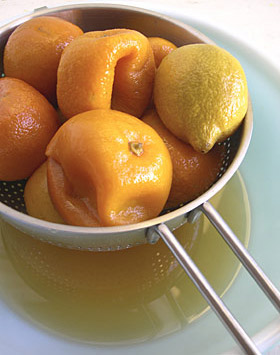
Some of the marmalade I made was beautifully glowing and orange, like looking through stained glass windows when holding the jars up to the light, the rest was slow cooked for several hours in the Rayburn till it ended up deep, dark, rich and caramelised. Both were lovely so I’d be hard pressed to choose which kind I prefer so am now making both types again this year. Find my recipe here.
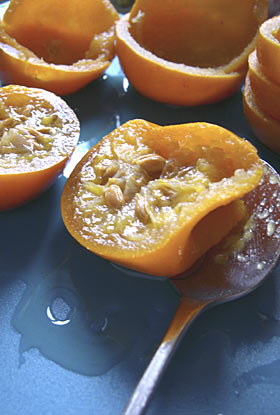
Seville oranges have such a strong character that they can withstand long cooking and still retain their own distinctive personality. You have to respect a fruit like that. It is worth putting some in the freezer so they’ll be available out of season for keeping the marmalade stock replenished, for making orange curd as well as for rustling up an impromptu bitter orange tart when called for. Just wash and dry the fruits, pack into plastic bags and seal before freezing.





